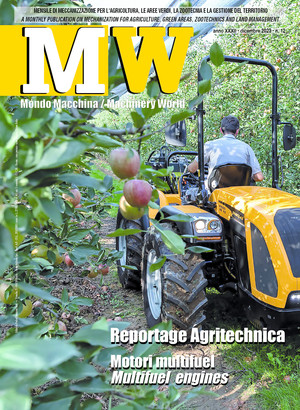
Lubricating oils: where is research headed
Work is being done on fluidity to reduce resistance and thus diesel fuel consumption, but also on tolerance to new fuels. Not forgetting, of course, the biodegradable bases
Oil, in modern agricultural machinery, is one of the most crucial elements to ensure their durability and smooth operation and, at the same time, one of the components that wear out the fastest. Although its lifespan has greatly increased thanks to new formulations, it should be changed at least once a year, but it goes up to two or three changes for vehicles used more frequently. It is not a stretch to say that in its working life, a tractor of the latest generation undergoes 20 to 30 oil changes- a number that has significant practical, economic, and even environmental implications. For example, an average-sized tractor with a service life of 10 thousand hours uses 350 to 500 liters of engine oil (depending on the maintenance interval) for a total expense (considering an intermediate price oil) ranging from 3,000 to 4,500 euros. As we specified just above, the count is made on the engine oil since several types are used on agricultural machinery. Generally, at least three: one for the engine, one for the transmission, and a third for the hydraulic circuit if it is separate from the transmission. To these is added, conventionally, the brake establishment fluid. Given its relevance and economic importance, we focus this in-depth study on oils for agricultural machinery to learn more about its nature, components and latest trends, which go, not surprisingly, toward the search for greater environmental sustainability.
What oil is made of. Regardless of its intended use, a modern mechanical oil consists of three components: base, additives and polymers, with the former alone accounting for three-quarters of the total volume, while additives make up about 15 percent of the compound and polymers do not go beyond 10 percent, on average. The latter are generally used to improve the performance of oil -particularly motor oil -when it is produced with medium or low-medium quality bases and can be a point of weakness for the oil itself, as they generally degrade in less time than the base they are supposed to improve.
The base and its groups. As the main component of oil, the base plays a key role in determining its quality. A bad base, no matter how correct and additivated, will never produce an oil with high performance and particularly unchanged over time. There are three types of bases: mineral, synthetic or regenerated. The former is obtained from petroleum, following a refining process that can be more or less thorough. This results in bases of varying purity, which make up the various groups into which this raw material is divided. Synthetic bases are derived from ethylenes, esters or PAOs, often in combination. For example, combining poly-alpha olefins with a Group 3 oil or an ester. Finally, regenerated bases come from the recovery of waste oils, a sector in which our country leads the world in efficiency. As we explain separately, the collection consortia system works great, recovering 99 percent of the oil in circulation. However, the resulting regenerated product is not always the same and generally belongs to the first group of bases. With subsequent refinements, it can be upgraded to Group 2 and thus also used for heavy-duty implementations such as in engines. More common, however, is to use these bases for hydraulic oils that do not need high quality and hold over time.
Additives and polymers. Additives are a necessary component of particular oils- for example, engine oils - as they improve certain essential characteristics, such as resistance to high temperatures or certain substances with which the oil will come into contact, starting with diesel fuel. It may surprise those unfamiliar with the subject, but waste oil contains up to 10 percent diesel fuel, collected during its cylinder lubrication function. Depending on the composition of the diesel fuel, as we shall see later, the need to add additives and their nature vary. Finally, we have polymers, which compensate for the deficiencies of the bases. A fundamental element comes into play here, such as the viscosity index, which explains how the oil behaves as temperature changes. When this index is below 100, good lubrication at high temperatures is not assured (a synthetic base, to have a term of reference, goes up to 160). Therefore, polymers are added to correct this defect. However, polymers, under mechanical action, such as gears' movement, deteriorate faster than the base. Therefore, there is a risk of having an oil with performance significantly different from that indicated on the label after a hundred hours of operation, resulting in wear and tear of mechanical components. In fact, the main function of oil is to maintain a protective film on the parts subjected to friction, preventing wear and damage. When oil degrades, this film becomes too thin, so mechanical parts come into contact and begin to wear. This phenomenon is also affected by the operating temperature: the higher it is, the more fluid the oil becomes and the thinner the protective film becomes. Multigrade oils were created precisely to maintain fairly uniform performance as temperature changes, but for this to happen, it is necessary to start from a good base, incurring higher costs. On the other hand, oil fluidity is becoming an advantage in certain contexts: a fluid oil flows better, offers less resistance to mechanical movement and therefore absorbs less power.
This is where research is going. New fuels, increasingly efficient transmissions, and increased hydraulic demands: these trends in the agricultural machinery sector are also closely affecting oil production. Fuels, particularly, are undergoing major changes. Today, diesel fuel contains a standard 7 percent biodiesel or fuel produced from plant sources. However, there are various formulations with up to 20 percent biodiesel. Then there is the complex issue of HVOs, an acronym that stands for Hydrotreated Vegetable Oil. This new fuel type is obtained by refining paraffinic hydrocarbons from plant sources such as waste edible oils, tallows, and high-yield, low-land-use crops. The nature of the fuel, as is easy to imagine, also influences oil performance. This is partly because diesel fuel is used in the Diesel engine to lubricate the top of the cylinder; therefore, a different fuel composition can change the level of this lubrication. Secondly, a non-negligible fraction of diesel fuel ends up in the oil. Since biodiesel leaves the combustion chamber wetter, more of it will be incorporated into the oil, which can reduce its performance faster. This is why oil producers work on blends that can better resist acidification and biodiesel contamination. Testing for compatibility between today's oils and fuels with increasing rates of biodiesel is also being carried out within Api and Acea-the American Petroleum Institute and the Association des Constructeurs Européens d'Automobiles, respectively, two bodies involved in oil research. The same is true, of course, for HVO-based fuels.
The fluidity factor. Another important driver of innovation is energy conservation, which is closely linked to environmental sustainability since the less diesel fuel used, the fewer emissions produced. In this regard, engine designers are studying solutions to use increasingly fluid oils. The motivation is physical: a smoother oil offers less resistance to crankshaft movement and the action of oil scrapers, reducing power dissipation and, consequently, fuel consumption. Moreover, fluidity is directly related to the ability to incorporate air and release it once it is incorporated. The presence of dispersed air creates problems for the oil because air carries water, which, at the elevated temperatures reached by oil in engines or certain hydraulic implementations, "explodes," causing carbon deposits. Therefore, a fluid oil captures less air and releases it more easily. This is why in some new engines, it is recommended to use, instead of the classic SAE 10W40, an SAE 10W30, and some manufacturers, such as Man, go as far as the SAE 5W20 (for automotive, at the moment). However, these products are to be used only in new-generation engines designed to work efficiently with these fluidity values. Similarly, research is being done to find additives that reduce foaming and air entrainment.
Transmission and hydraulics. Modern transmissions, both powershift and particularly continuously variable, require specific oils, usually SAE 10W30, belonging to the UTTO (Universal Tractor Transmission OIL) category. However, some manufacturers are turning to products with higher performance, such as those in the STOU (Super Tractor Oil Universal) category: oils suitable, certainly, for the transmission but with some of the qualities peculiar to engine oil in the areas of detergency and contaminant dispersion capacity. This is a choice for the sake of quality and efficiency, but it also has clear marketing implications. Finally, we close with a brief mention of hydraulic oils. Of the three classes of oil found in agricultural machinery, they require the lowest specifications in terms of holding over time and viscosity, yet on the other hand, they tend to come out of the tractor to do their job. This implies that they can be dispersed into the environment with greater ease and, secondly, incorporate air or moisture, creating the carbon residues mentioned earlier. To avoid serious contamination of the soil, which is possible both in the case of hydraulic hose ruptures and in the normal engagement and disengagement of the sockets, there is an increasing focus on biodegradable hydraulic oils, which are, at the moment, one of the most prolific strands of research in agricultural oil.
Biodegradable oil. The biodegradability of oil is a different thing from its environmental impact: the latter is measured by its carbon footprint, which is the calculation of how much CO2 is emitted in the process of production, use and disposal (or recycling) of the oil and all its components: bases, polymers, additives, packaging. Biodegradability, on the other hand, indicates the time it takes for an oil dispersed in the environment to degrade and is a kind of insurance against pollution caused precisely by accidental dispersion. Needless to say, this characteristic is much more important for hydraulic establishment fluids than for engine and transmission oils, for which the use of plant or bio bases is, at present, marginal. So, let us see how to obtain a biodegradable oil. There are two ways: use a vegetable base, that is, from crops such as rapeseed or castor oil, or synthetic, such as an ester or, more rarely, a kerosene. In either case, the base needs to be, in case it is found in nature, attackable by bacteria and, therefore, precisely, degradable. What differentiates performance in an organic oil is the saturation of the base: the more unsaturated it is, the more it tends to oxidize, that is, to bind with oxygen atoms, losing its characteristics. This process is favored by high temperatures (70° and above). Oxidation results in acidification, increasing TAN (Total Acid Number) and the need for close maintenance. Biodegradable bases are also more hygroscopic, meaning they retain more water in emulsion. Acidity, moisture and high temperatures increase the risk of carbon deposits, which can damage the establishment's components in the long run. High-quality raw materials and additives that enhance product performance are therefore needed. This, combined with the production process, raises the cost of biodegradable oils, which consequently maintain a higher price than fossil-based oils. However, there is no doubt that, at least for hydraulic oil, biodegradability is an almost obligatory path. Besides the clear environmental benefits, in fact, both public attention and regulatory trends must be taken into account: already some specifications of organic supply chains provide for biodegradable oils wherever possible, and it is not certain that this path will not be followed sooner or later for conventional agricultural products as well.
The five bases of oil
There are five: Group 1 bases are those subjected to refining only and have a high saturated compound coefficient and a sulfur level, sometimes above the maximum allowable limits. Subjected to hydrogen treatment, they become more saturated and lose sulfur, thus moving to Group 2. Subsequent hydrotreatment with pressurized hydrogen allows the jump to Group 3, which generally contains synthetic bases. The latter are the only components of Group 4, which groups poly-alpha-olefins (PAOs): totally synthetic bases, generally obtained from suitably treated ethylene molecules. Finally, the fifth and last group is a container for all bases that cannot be traced back to the previous groups. Thus, we find silicone bases, glycolic bases, bases produced from esters, etc.
Recovery and regeneration: Italy is virtuous
Italy is a country to imitate when it comes to separate waste collection and recycling. It also applies in the field of mechanical oils since 46 percent of the oil put on the market is collected in our country, compared to a European average of 41 percent. Even wider is the gap if we talk about regeneration: 99% of the collected oil is transformed into new bases, while it does not reach 50% in Europe. At the heart of the entire process stands Conou, the Compulsory Consortium of Used Oils, established in 1983 as Coou. An example of a public-private structure that, according to what all parties say, works decidedly well, thanks to the fact that it operates free of charge. The supply chain covers the collection costs at the production stage: delivering the oil to the Conou, on the other hand, costs nothing. The regeneration of the oil goes through the elimination of water and the residues it contains (up to 25 percent between bitumen and diesel). A process at the end of which the regenerated bases can be used in various implementations.








